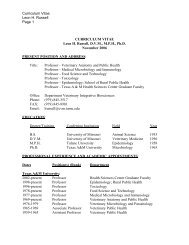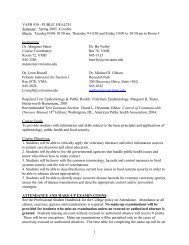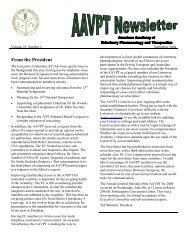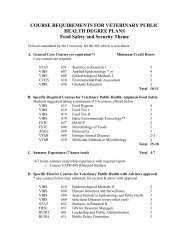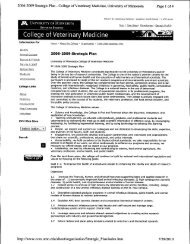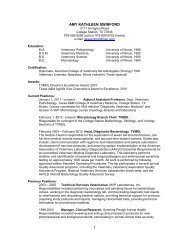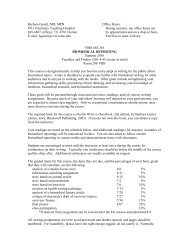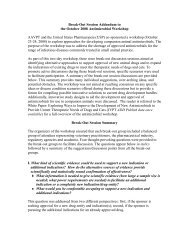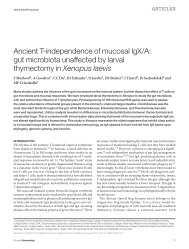Download Brochure - College of Veterinary Medicine - Texas A&M ...
Download Brochure - College of Veterinary Medicine - Texas A&M ...
Download Brochure - College of Veterinary Medicine - Texas A&M ...
You also want an ePaper? Increase the reach of your titles
YUMPU automatically turns print PDFs into web optimized ePapers that Google loves.
Spinal cord injuries affect between 200,000<br />
and 1,000,000 people in America and are<br />
also extremely common in dogs. Injured<br />
dogs may develop permanent weakness,<br />
urinary incontinence, and pain. While<br />
standard treatments such as decompressive<br />
surgery and rehabilitation may be effective<br />
in some cases, new approaches are needed<br />
to improve recovery. In 2011 veterinarians<br />
from <strong>Texas</strong> A&M University partnered<br />
with medical doctors and scientists from<br />
the University <strong>of</strong> California-San Francisco<br />
Medical School to develop treatments for<br />
spinal cord injuries. The United States<br />
Department <strong>of</strong> Defense provided funding<br />
to support this team-based research effort<br />
in the hope that results would positively<br />
impact our troops and our dogs.<br />
Those with inquires<br />
are encouraged to contact:<br />
<strong>Texas</strong> A&M University<br />
<strong>College</strong> <strong>of</strong> <strong>Veterinary</strong> <strong>Medicine</strong><br />
& Biomedical Sciences<br />
Department <strong>of</strong> Small Animal<br />
Clinical Sciences<br />
979-845-2351
Common Questions<br />
Which dogs are eligible to participate?<br />
• Male dogs or male castrated dogs<br />
weighing between 5 and 15 kg that<br />
are non-ambulatory<br />
• dogs must also have a disk-related<br />
spinal cord injury between the T3--L3<br />
vertebrae<br />
• the injury must have occurred less<br />
than 48 hours before admission to<br />
<strong>Texas</strong> A&M <strong>College</strong> <strong>of</strong> <strong>Veterinary</strong><br />
<strong>Medicine</strong><br />
• the dog must be an appropriate<br />
candidate for surgery<br />
• dogs that received steroid drugs<br />
(eg, prednisone, Solumedrol®,<br />
dexamethasone) cannot participate<br />
as these medications interfere with<br />
the study drug<br />
What procedures will be<br />
performed?<br />
The client consent form provides<br />
procedural details. Briefly, dogs<br />
will have an injection <strong>of</strong> placebo<br />
or drug under the skin. They<br />
will have a blood draw prior to<br />
the administration <strong>of</strong> drug and 3<br />
days afterwards. All dogs will be<br />
required to have sedation prior<br />
to surgery and 3, 7, and 42 days<br />
following surgery so that urinary<br />
voiding can be studied using<br />
procedures that are commonly<br />
performed in humans with spinal<br />
cord injury.<br />
Work being performed at <strong>Texas</strong> A&M assess the effect <strong>of</strong> a drug that blocks destructive<br />
enzymes that can further damage the spinal cord after disk-related injury. The drug<br />
has been used in mice, dogs, and humans with few ill effects. All eligible dogs enrolled<br />
in the study will receive standard medical treatment (surgery, pain management, and<br />
rehabilitation) and will be randomized to receive either placebo or the drug. Dogs will<br />
have to stay at our facility for 7 days and return for 42 day post-surgery re-check.<br />
What does the study pay for?<br />
Clients permitting enrollment<br />
<strong>of</strong> their dogs will have their bill<br />
capped at $1200, assuming a 7 day<br />
stay and no major complications.<br />
This bill will be for all standard<br />
services (examination, vertebral<br />
imaging, blood work, surgery,<br />
ICU stay, and rehabilitation) as<br />
well as study related procedures.<br />
Normally, standard clinical services<br />
for disk herniation cost $3500. If<br />
for some reason a dog proves not<br />
to be eligible after enrollment<br />
(eg, MRI shows injury was due to<br />
inflammation or tumor),<br />
additional treatments may be<br />
elected by the client on a fee-forservice<br />
basis.




